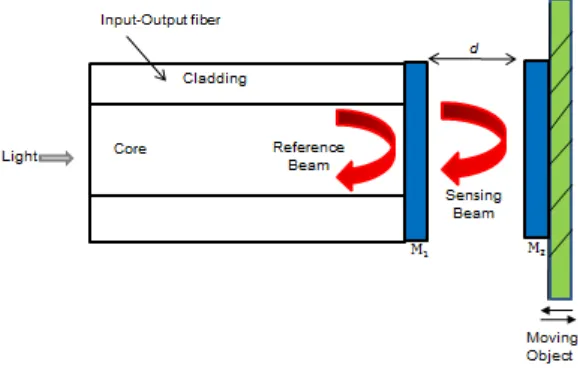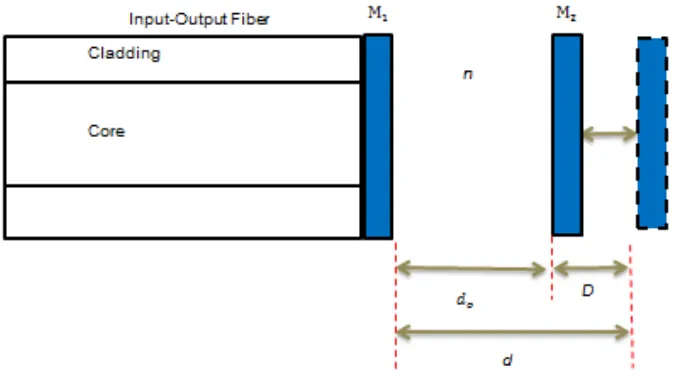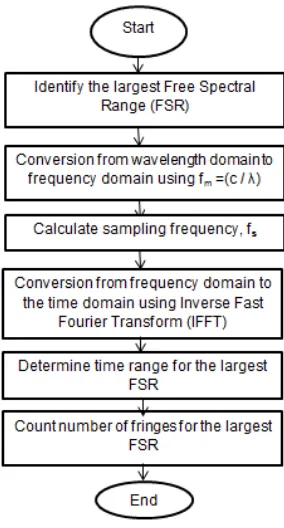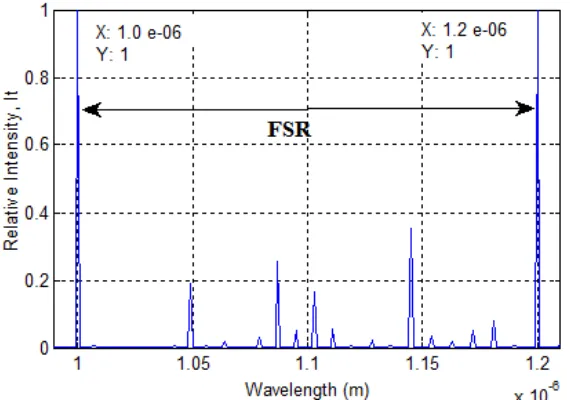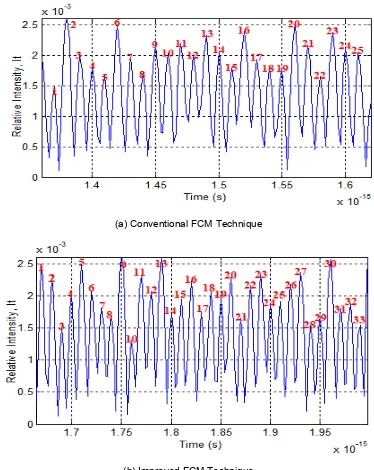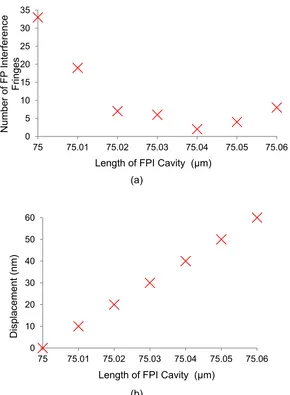DOI: 10.12928/TELKOMNIKA.v12i4.123 811
Resolution Improvement in Fabry-Perot Displacement
Sensor Based on Fringe Counting Method
Nur Izzati Ismail, Nor Hafizah Ngajikin, Nor Fadzlina Mohd Zaman, Maisarah Awang, Asrul Izam Azmi, Nik Noordini Nik Abd. Malik, Norazan Mohd Kassim
Lightwave Communication Research Group (LCRG) Faculty of Electrical Engineering, Universiti Teknologi Malaysia
81310 Johor, Malaysia, Ph: +607-5535302 e-mail: izzati.ismail@fkegraduate.utm.my
Abstract
This paper presents an improved Fringe Counting Method (FCM) technique in order to enhance the displacement resolution of a Fabry-Perot Displacement Sensor (FPDS). A simulation model of a FPDS based on the improved FCM has been developed and simulated for nanometer displacement range by using MATLAB mathematical software. Unlike conventional FCM that analyzed the number of fringes produced over one time period, the improved FCM analyzed the number of fringes for one largest Free Spectral Range (FSR). In this work, the initial length of Fabry-Perot Interferometer (FPI) cavity has been
set at 75 ȝm due to limitation of the machining precision equipment. For the displacement analysis, the
improved FCM technique is used as an algorithm. The research results prove that this FPDS could detect displacement at 10nm resolution over a working range of 40 nm. It showed that the improved FCM technique managed to enhance the capability of the conventional FCM in detecting nanometer displacement.
Keywords: fringe counting method, fabry-perot displacement sensor, faby-perot interferometer
1. Introduction
Displacement as one component in vibration can be detected by a variety of displacement sensors working based on different principles. These sensors work based on capacitive, inductive, piezoelectric and most recently using optical technology [1]-[2]. Displacement sensor based on optical technology has drawn increasing attention from manufacturers and researchers since it can give remarkable performances in high sensitivity, lightweight, fast response and immunity to electromagnetic interference (EMI) [3]-[4]. There are three types of optical based displacement sensors which are Intensity-Based Sensors (IBS), Fabry-Perot Interferometer (FPI), and Fiber Bragg Grating (FBG). Among these three methods, FPI is more preferred since it provides high displacement resolution [5]. This type of sensor is also called as Fabry-Perot Displacement Sensor (FPDS).
system, this technique is limited to displacement detection up to micrometer range only. It is only possible to reach nanometer displacement detection with some modification in FCM technique [13]-[14]. Therefore, in this paper, a new fringe counting mechanism has been developed in order to enhance the FPDS resolution and called as the improved FCM technique. This technique is discussed in details in the following section. The developed FPDS based on the improved FCM simulation model is analyzed in terms of number of fringe for a specific displacement.
2. Working Principle of FPDS
FPI is a passive optical structure that used multiple-beam interference in a cavity between two semi reflective surfaces [15]. This FPI configuration is used for nanometer displacement detection in this project. Figure 1 shows the FPDS configuration in detecting displacement. Reference beam in this figure is the reflection from fiber-air interface at the front of the cavity while sensing beam is the reflection of fiber-air interface at the back of the cavity. Mirror M2 that attached to the moving object will move backward and also forward, hence changes the length of FPI cavity, d. This changes lead to significant alteration of phase difference (φ) between reference reflection and sensing reflection in FPDS operation as stated in (3). These two beams signal interfere with each other and resulted in the variations of FPI interference signal as presented in (1).
Figure 1. FPDS Concept in Displacement Sensing
According to the multi-beam interference principle, the normalized transfer function of the reflected interference spectrum at wavelength λ is given by the well-known Airy function. It can be expressed as below [16].
(1)
Where (2)
and phase difference, (3)
3. FPDS Based on the Improved FCM Technique 3.1. FPDS Simulation Model
As afore mentioned, the improved FCM is developed to enhance resolution of conventional FCM for nanometer range displacement detection. In order to evaluate performance of the new improved method, a simulation model based on equations (1-3) is developed using MATLAB mathematical software. Several important parameters in FPDS structure are analyzed in 2-dimensional analysis which are length of the FPI cavity and mirror reflectivity.
Figure 2 shows the illustration of the developed FPDS model. The initial length of FPI cavity, do is chosen to be at 75 µm due to limitation in precision machining equipment. Length of FPI cavity is increased by nanometer variation for each simulation. Hence, the length of FPI cavity undergoes a continuous change with a certain displacement, D, thus resulting in a new d. This displacement variation analysis is needed in order to obtain displacement resolution of the sensor. The other parameters involved in this simulation are as tabulated in Table 1.
Figure 2. Modelling of FPDS in MATLAB Software
Table 1. FPDS Simulation
Parameters Values Initial length of FPI cavity, d0 75 µm
Mirrors reflectivity, R 98%
Refractive index of FP cavity, n 1.0
Light incident angle at M1 0°
3.2. The Improved FCM Technique
Based on FCM technique, a large number of counted fringes produced will improve resolution of the FPDS. Therefore, this paper presents an improved fringe counting method that considers total number of fringes in the largest FSR instead of one time period in conventional FCM. Process steps for both counting methods are illustrated in flow charts in Figure 3.
(a) Conventional FCM Technique
(b) Improved FCM Technique
Figure 4. Relative Output Intensity of FPDS in Wavelength Domain Representation (d0= 75 µm)
Fringe calculation in both FCM techniques is done in time domain analysis. Hence, the optical spectrum needs to be transformed into time domain representation. The following equations are used for the transformation process.
Operating frequency, fm = (4)
Sampling frequency, fs = 2 fm (5)
Time, (6)
Where c is speed of light, Ȝ is operating wavelength and L is length of the signal.
(a) Conventional FCM Technique
(b) Improved FCM Technique
Figure 5. Relative Output Intensity of FPDS in Time Domain Representation for Both Techniques (d0= 75 µm)
4. Results and Discussion
(a)
(b)
Figure 6. (a) Counted Number of FP Interference Fringes for a Specific Length of FPI Cavity and (b) Detected Displacement for a Specific Length of FPI Cavity
5. Conclusion
FPDS based on the improved FCM technique is developed and presented in this paper. Analytical model of FPDS is simulated by using initial length of the FPI cavity of 75 µm. From the simulation, FPDS with a displacement resolution of 10 nm and working range of 40 nm are realized with the used of the improved FCM technique. These results are obtained for 75 µm initial length of FPI cavity with a light source ranging from 600 nm to 1700 nm wavelength. The proposed FPDS configuration is targeted for applications that require a nanometer displacement detection such as microscope, telescope, and also disk slider. The application of this FPDS can be extended to many other applications since it offers the immunization to EMI, lightweight and also ease of implementation.
References
[1] Chaurasiya H. Recent Trends of Measurement and Development of Vibration Sensors. International
Journal of Computer Science Issues (IJCSI). 2012; 9(4).
[2] Santoso DR. A Simple Instrumentation System for Large Structure Vibration Monitoring. Indonesian
Journal Of Elektrical Engineering. 2010; 8(3): 265-74.
[3] Lee BH, Kim YH, Park KS, Eom JB, Kim MJ, Rho BS, et al. Interferometric fiber optic sensors.
Sensors. 2012; 12(3): 2467-86.
0
75 75.01 75.02 75.03 75.04 75.05 75.06
Number of FP
Interference
Fringes
Length of FPI Cavity (µm)
0
75 75.01 75.02 75.03 75.04 75.05 75.06
Displacement (nm)
[4] Mhdi B, Ministry of S, Technology BI, Aljaber N, Ministry of S, Technology BI, et al. Design and construction of optical fiber sensor system for detection of stress and fine motion. International Journal
of Nano Devices, Sensors and Systems (IJ-Nano). 2012; 1(1): 25-33.
[5] García YR, Corres JM, Goicoechea J. Vibration detection using optical fiber sensors. Journal of
Sensors. 2010; 2010.
[6] Chen J-H, Huang X-G, Zhao J-R, Tao J, He W-X, Liu S-H. Fabry–Perot interference-based fiber-optic
sensor for small displacement measurement. Optics Communications. 2010; 283(17): 3315-9.
[7] Zhou X, Yu Q. Wide-range displacement sensor based on fiber-optic Fabry–Perot interferometer for
subnanometer measurement. Sensors Journal, IEEE. 2011; 11(7): 1602-6.
[8] Seat H, Chawah P, Cattoen M, Sourice A, Plantier G, Boudin F, et al. Dual-modulation fiber
Fabry-Perot interferometer with double reflection for slowly-varying displacements. Optics letters. 2012;
37(14): 2886-8.
[9] Jia P, Wang D. Self-calibrated non-contact fibre-optic Fabry–Perot interferometric vibration displacement sensor system using laser emission frequency modulated phase generated carrier
demodulation scheme. Measurement Science and Technology. 2012; 23(11): 115201.
[10] Gangopadhyay TK, Henderson PJ. Vibration: history and measurement with an extrinsic Fabry–Perot sensor with solid-state laser interferometry. Applied optics. 1999; 38(12): 2471-7.
[11] Gangopadhyay TK. Non-contact vibration measurement based on an extrinsic Fabry–Perot
interferometer implemented using arrays of single-mode fibres. Measurement Science and
Technology. 2004; 15(5): 911.
[12] Sathitanon N, Pullteap S. A Fiber Optic Interferometric Sensor for Dynamic Measurement.
International Journal of Computer Science & Engineering. 2008; 2(2).
[13] Seat HC, Pullteap S. An extrinsic fiber Fabry-Perot interferometer for dynamic displacement
measurement. Mechatronics and Automation, 2007 ICMA 2007 International Conference. 2007.
[14] Pullteap S. Development of a Fiber based Interferometric Sensor for Non-contact Displacement
Measurement. International conference on Computer, Electrical, and Systems Science, Paris
(France). 2010.
[15] Iizuka K. Elements of Photonics, In Free Space and Special Media: John Wiley & Sons. 2002.
[16] Ngajikin NH, Kassim NM, Mohammad AB, Witjaksono G. Wide range of electrostatic actuation MEMS
FPOTF. Progress In Electromagnetics Research C. 2009; 9: 155-69.
